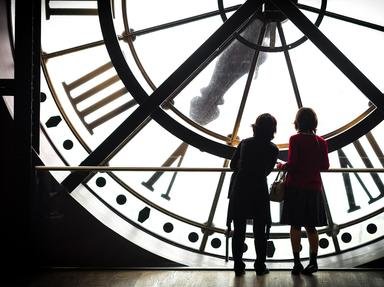Quiz Answer Key and Fun Facts
1. In what year of the original Roman calendar did Julius Caesar, with help from the Greek astronomer, Sosignenes,adopt the Julian Calendar?
2. The year for the Julian Calendar was 365.25 days but the vernal equinox year was 365.2424 days. How many days had the Julian Calendar drifted off the Equinox (Solar) year by the year 1582 A.D.?
3. When Gregory XIII became Pope, he accepted the recommendations of Jesuit Christopher Clavius for calendar reform and issued his papal decree, which established the Gregorian Calendar. Which change was made to comply with his decree?
4. What did George Washington do in order to encourage the reluctant colonies to adopt the Gregorian Calendar, which also meant changing the 1st day of the New Year from March 25th to January 1st?
5. Which country of the following did not adopt the Gregorian Calendar until the 20th Century?
6. Which month of the year is named for the Roman god Mars, god of war and guardian of the state?
7. Which Month of the year is named for the Roman Festival of Purification?
8. Which Day of the week is Mercury's Day and named for the Roman god of peace and prosperity and for a Teutonic god?
9. Which Day of the week is named for the Scandinavian goddess of love?
10. Which Day of the week is named for the Anglo-Saxon warrior god?
11. How does the 'Common Era Calendar' (CE) or astronomical system of numbering the years differ from the Gregorian Calendar?
12. Is the Solar Year a constant at 365.2424 days?
13. The Second is the unit of Time adopted by the International System of Units in France. What chemical element is used to measure a 'second' with an accuracy better than one second in six million years?
14. In the International System of Units, the meter is the unit of length, which is defined as 'the length traveled by light in a vacuum during a time interval of 1 over 299,792,453 seconds'. In our every day use how many inches are there in one meter?
15. John leaves Town A. at 12:02 PM and drives to Town B. a distance of 120 miles. His average speed for the first 60 miles was 50 mph and for the final 60 miles it was 40 mph. Jim leaves Town A. at 12:20 PM and also drives to Town B. What must Jim's average speed be in order to arrive at Town B at the same time that John arrives?
Source: Author
YOMD39
This quiz was reviewed by FunTrivia editor
rossian before going online.
Any errors found in FunTrivia content are routinely corrected through our feedback system.

